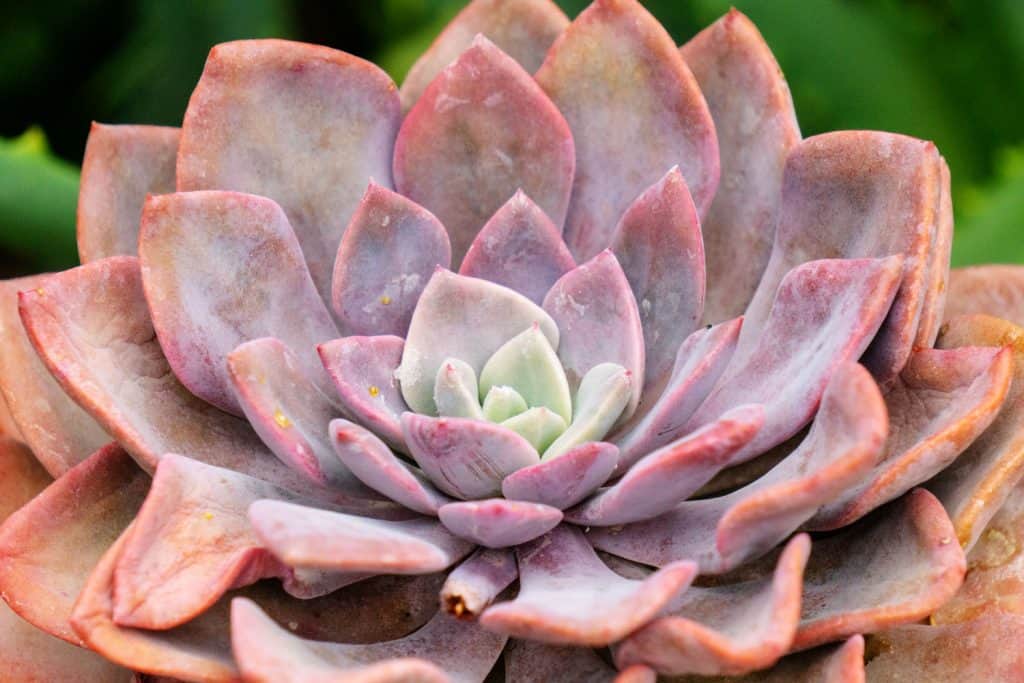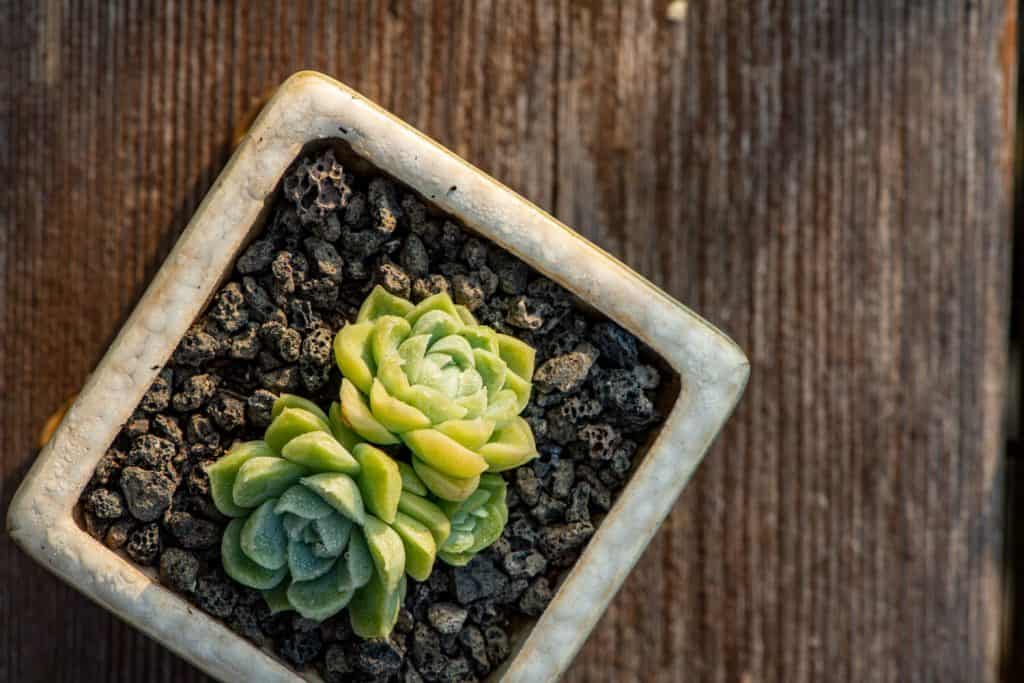Figuring out what's wrong with your plants can be a difficult endeavor sometimes. Have you noticed your Echeveria start to die but don't know what caused it to happen? We have all the information you need to know.
There are a few reasons your Echeveria might be dying. Most often, overwatering an Echeveria will cause it to die, so try to keep its water to a minimum. Another leading cause is not getting enough sun, so make sure your succulent is in a bright, warm spot.
On top of that, Echeveria also needs nutrient-rich, well-draining soil. So if your plant is dying, it might be time to switch things up!
As we begin, we will cover all things Echeveria and discuss how to keep them alive and healthy. Whether you want to start a succulent garden or have one going, it is essential to properly care for your plants. With that said, let's dive right into this post!
![A bright blooming pink echeveria, Why Is My Echeveria Dying? [With Tips On What To Do About It]](https://gardentabs.com/wp-content/uploads/2021/10/Why-Is-My-Echeveria-Dying-With-Tips-On-What-To-Do-About-It-683x1024.png)
How Do You Know Echeveria Is Dying?
Generally, you should be able to tell if your Echeveria is dying by taking a look at its leaves. Typically, yellowish-brown or wilting leaves are an easy indicator that something is wrong with your succulent, so make sure to examine it frequently.

Another sign that your plant is dying is if its stem turns black and is mushy to the touch. This happens when you overwater Echeveria and can be very difficult to reverse.
Will A Dying Echeveria Lose All Of Its Leaves?
Although a dying Echeveria shouldn't lose all of its leaves, you will notice it thin out a bit towards the bottom. Most times, Echeveria will become fragile as they die and drop their leaves with the slightest bump or movement.
That said, it is normal for a succulent to lose some of its foliage, but not to the point it becomes bare towards the bottom.
How Do You Save A Dying Echeveria Succulent?
If you find yourself struggling to keep an Echeveria alive, there are ways to save it.
First:
- Allow your succulent to dry out for a week or two if you suspect it has been overwatered.
- Place your Echeveria succulent in a bright, warm location where it won't be bothered.
- Repot your Echeveria and replace its soil to prevent a potential disease from spreading.
- Fertilize your succulent with a slow-release formula to give it a much-needed boost.
Although these are just some ways to revive a dying Echeveria, giving your plant time to heal and regrow is essential, so don't get discouraged if you don't see results right away.
Can You Bring A Dead Echeveria Back To Life?
When it comes to bringing a dead Echeveria back to life, this depends on how far gone it is. Generally, if your succulent's base has turned brown or black and all of its leaves have fallen, it is too late to save it.
That said, if there are still signs of life, like a green leaf or a slightly colored base, you might be able to keep your plant alive.
What Does An Overwatered Echeveria Look Like?

Typically, an overwatered Echeveria will have much lighter, mushier leaves than a healthy plant. An overwatered Echeveria can even develop translucent leaves, which easily become top-heavy and fall off your plant.
Adding to that, they also mention how signs of an overwatered succulent will show towards the bottom of your plant first, so that is an area you want to keep an eye on.
How Often Should You Water Echeveria?
Water-wise, we recommend only watering Echeveria every seven to ten days. Of course, this will depend on how big your succulent is and how much daily sun it gets, but plan to water once per week.
According to Plant Care Today, you're better off underwatering than overwatering an Echeveria, so if you miss a few days, you shouldn't need to worry.
Why Is My Echeveria Shriveling?
Shriveling is usually due to either over or underwatering. To tell the difference, take a look at the color of your plant's leaves, and if they appear light/clear, it is overwatered.
If your Echeveria's leaves are yellowish-brown, your plant probably needs a bit of water. That said, succulents do not like tons of water at one time, so try to ease your plant back into being watered over a few days.
How Do I Know If My Succulent Needs More Water?
Generally, if the leaves on a succulent are shriveled up or turning yellowish-brown, it's time for some water. As we mentioned above, it is good to water an Echeveria every seven to ten days, so creating a watering schedule is a great way to avoid underwatering your succulent.
On top of that, a well-watered succulent will have firm, plump leaves, so if your plant's leaves feel super brittle and thin, it needs more water.
Soil Moisture Meter
This soil moisture meter gives instant results, is easy to read, and promises not to damage your plant's roots.
Follow this link to see it on Amazon here.
Why Is My Succulent Turning Brown At The Bottom?
If your succulent starts to turn brown near the bottom, it could be overwatered or sunburned. Like we covered, an overwatered succulent will essentially begin to bloat, which can lead to its base rotting alongside its roots.

If your succulent becomes sunburned, this can also make it turn brown near the bottom, so if you recently moved it, the sun might be to blame. Between the two, there is a higher chance your succulent got too much water rather than a sunburn, but again, every plant is different.
Why Is My Succulent Dying At The Bottom?
When it comes to why your succulent is dying at the bottom, this could be due to a lack of sunlight or that it doesn't have enough water. Generally, succulents show their signs of illness at the bottom first, so this is an area you want to monitor closely.
That said, we recommend feeling your succulent's soil, making sure its leaves are plump/firm, and ensuring it is getting enough sunlight. Doing this can stop it from dying entirely and will help you get an idea of what is wrong with your plant.
Should You Repot A Dying Echeveria?
For those with a dying Echeveria who want to try repotting, we think this is a good idea in some cases. If your succulent was overwatered, we recommend letting it dry out for a day or two before repotting to keep its roots from breaking in their new soil.
If your Echeveria is dying because it needs water or has a sunburn, we would not recommend repotting unless it is necessary. Doing this can send your plant into shock, which will be the final nail in its coffin in most situations.
How Often Should You Repot Echeveria?
It is a good idea to repot Echeveria every two years. Doing this will refresh its soil and give it more space to grow depending on how big it is getting.
You should try to repot your succulents at the beginning of their growing season because it gives them the best chance of survival. When it comes to what soil you should use, we recommend a sandy, slightly acidic option with great drainage.
To Wrap Things Up
Whether you are new to Echeveria or have a few growing, it is essential to act quickly if you start to notice your succulent die. From what we found, overwatering, little sun exposure, and poor quality soil can all be to blame for a dying Echeveria, but there are ways to fix this.
When it comes to saving a dying Echeveria, make sure to let it completely dry out before adding any more water, and make sure to place it somewhere bright and warm. We also recommend repotting your succulent and giving it new soil if it starts to die unless it is underwatered/has a sunburn. Regardless, remember to only water your Echeveria every seven to ten days, and don't be afraid to fertilize it regularly.
Want more plant content? Check out these helpful plant posts below!
11 Types Of Echeveria You Should Consider For Your Succulent Garden

